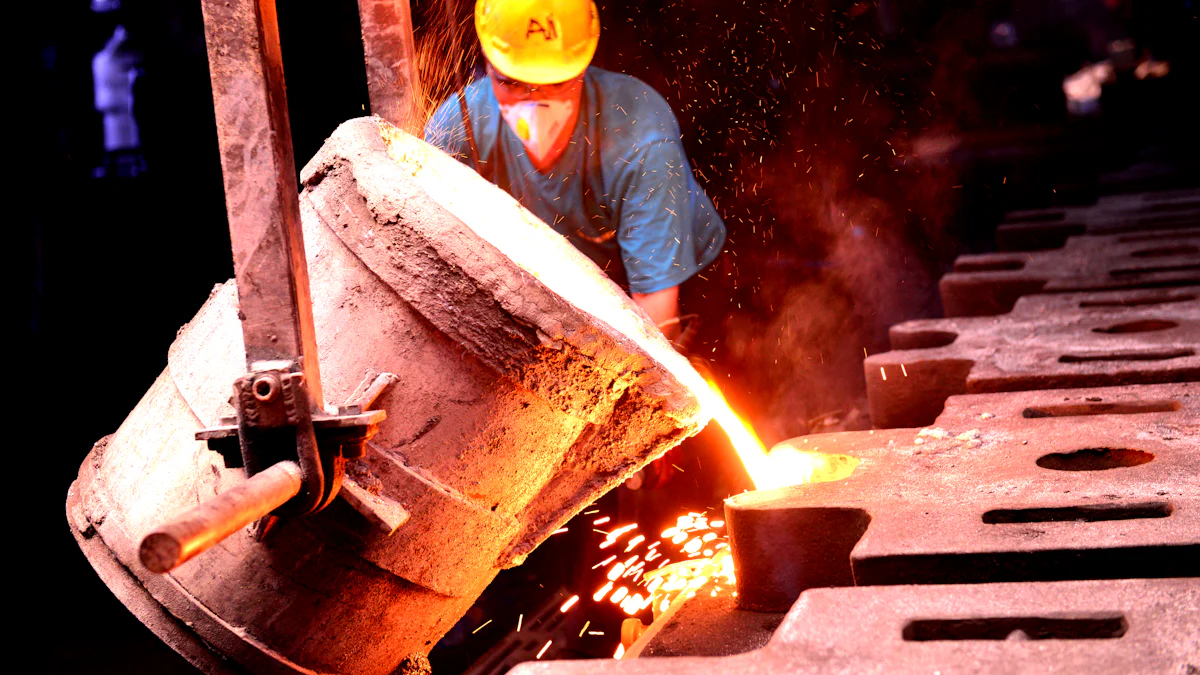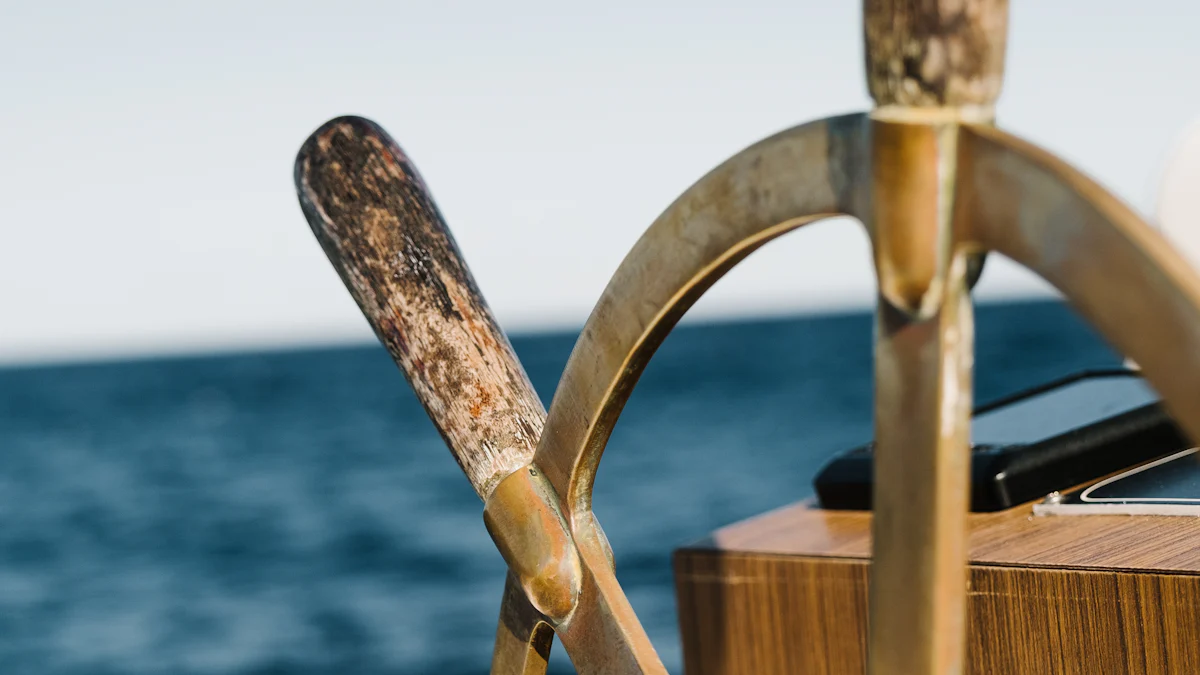
Brass precision castings are crafted using a meticulous process that shapes brass, an alloy of copper and zinc, into durable components. Their exceptional resistance to saltwater corrosion makes them indispensable in marine systems. These castings ensure reliability in critical parts like inlet and outlet end caps-brass precision castings, enhancing the efficiency of marine vessels and heat exchangers. Additionally, the use of Silica Sol Precision Casting and Tin Bronze Precision Casting techniques further improves the quality and performance of these components. The Lost Wax Investment Casting method also contributes to the precision and durability required in marine applications.
Properties of Brass for Precision Castings

Corrosion Resistance in Marine Environments
Brass stands out as a top choice for marine applications due to its exceptional resistance to corrosion. This is especially true for naval brass, which includes elements like tin and arsenic to combat common issues such as dezincification. These additions enhance its ability to withstand the harsh effects of seawater, making it ideal for components like inlet and outlet end caps in marine systems.
Compared to other materials, brass offers moderate corrosion resistance. For example:
| Material | Corrosion Resistance | Key Issues |
|---|---|---|
| Brass | Moderate | Susceptible to dezincification |
| Bronze | High | Better suited for seawater applications |
Despite its moderate rating, brass remains a reliable option for many marine components, thanks to its balance of performance and cost-effectiveness.
Strength and Durability of Brass
Brass precision castings are known for their mechanical strength and durability, which are critical in marine environments. Naval brass, for instance, resists wear, erosion, and fatigue, ensuring long-lasting performance. Its ultimate tensile strength ranges from 58 to 72 ksi (400 to 500 MPa), while its shear strength falls between 37 and 43 ksi (250 to 300 MPa). These properties allow brass components to endure high stress and physical demands.
Additionally, alloys like 464 Brass combine strength with rigidity, making them suitable for structural applications. This ensures that marine components, such as propellers and bearings, can handle the constant pressure and movement they face in operation.
Machinability and Design Flexibility
Brass’s excellent machinability makes it a favorite for creating complex designs in marine systems. Its ability to be easily shaped and cast allows manufacturers to produce intricate components like propellers, valves, and fittings. This flexibility is particularly valuable in shipbuilding, where precision and reliability are essential.
For example, brass fittings and valves play a crucial role in marine plumbing systems, ensuring secure and leak-free connections. The alloy’s strength and corrosion resistance further enhance its suitability for demanding applications, such as offshore platforms and subsea installations. These qualities make brass a versatile and dependable material for marine precision castings.
The Process of Creating Brass Precision CastingsOverview of the Precision Casting Process
Creating brass precision castings involves several carefully executed steps to ensure high-quality results. Here’s a breakdown of the process:
- Molding: A mold is prepared to shape the final product. This step includes creating a pattern and placing cores to form internal cavities.
- Melting: The brass alloy is heated to its melting point. Precise temperature control ensures the alloy’s properties remain intact.
- Pouring: The molten brass is poured into the mold. Careful techniques prevent defects like air pockets or uneven filling.
- Cooling and Solidification: The brass is allowed to cool and solidify. This step ensures a uniform grain structure for enhanced strength.
- Finishing: The mold is removed, and the casting undergoes cleaning, machining, and surface treatments to meet design specifications.
This process ensures that brass components meet the rigorous demands of marine systems, where reliability is critical.
Importance of Quality Control in Marine Applications
Quality control plays a vital role in producing brass precision castings for marine use. Every stage, from molding to finishing, undergoes strict monitoring to meet performance standards. Non-destructive testing methods, like X-ray inspections, detect internal defects such as porosity or cracks. Statistical process control (SPC) helps manufacturers track key parameters like temperature and pressure, allowing adjustments before issues arise.
Without proper quality control, defects like gas porosity or shrinkage can compromise the casting’s integrity. For marine systems, this could lead to failures in critical components, jeopardizing safety and efficiency.
Tip: High-quality brass castings undergo air-tightness tests to ensure they can withstand pressures up to 0.9 MPa without leakage, making them ideal for marine environments.
Common Alloys Used in Brass Precision Castings
Different brass alloys are tailored for specific marine applications. Naval brass, for instance, includes tin and arsenic to resist seawater corrosion and dezincification. Red brass, with its high copper content, excels in plumbing and marine hardware due to its durability. Aluminum brass, strengthened with aluminum, is perfect for heat exchangers exposed to seawater.
- Marine Brass: Combines zinc, tin, or lead for enhanced corrosion resistance.
- DZR Brass: Mitigates dezincification while remaining cost-effective.
- Aluminum Brass: Offers superior strength and durability in harsh marine conditions.
These alloys ensure that brass precision castings perform reliably in demanding environments, from propellers to heat exchanger components.
Applications of Brass Precision Castings in Marine Systems

Propellers and Impellers
Brass precision castings play a vital role in manufacturing marine propellers and impellers. These components must endure constant exposure to seawater and high mechanical stress. Brass, particularly the ZCuZn16Si4 alloy, offers excellent corrosion resistance and durability, making it a reliable choice. The material’s ability to form a protective oxide layer prevents further oxidation, ensuring long-lasting performance.
| Advantage | Description |
|---|---|
| Corrosion Resistance | Brass castings resist saltwater corrosion, ensuring longevity. |
| Durability | They withstand wear and tear in demanding marine environments. |
Propellers and impellers crafted from brass precision castings maintain efficiency and reliability, even in harsh conditions. This makes them indispensable for marine vessels.
Valves, Fittings, and Connectors
Valves, fittings, and connectors in marine systems rely on brass for its unmatched resistance to seawater corrosion. Small additions of tin and arsenic enhance the alloy’s performance, preventing dezincification. Brass fittings also provide excellent strength and wear resistance, ensuring secure and leak-free connections.
- Brass fittings resist corrosion from water and humid environments.
- Naval brass, with its high zinc content, offers superior strength and durability.
- These components are ideal for plumbing and outdoor marine applications.
Brass precision castings ensure that valves and connectors perform reliably, even under high pressure and constant exposure to moisture.
Bearings and Bushings
Bearings and bushings made from brass precision castings are essential for reducing friction in marine systems. The material’s strength and machinability allow for precise designs that fit seamlessly into complex machinery. Brass bearings resist wear and corrosion, ensuring smooth operation in propellers, pumps, and other moving parts.
Inlet and Outlet End Caps-Brass Precision Castings
Inlet and outlet end caps-brass precision castings are critical in marine heat exchanger systems. These components, made from ZCuZn16Si4 alloy, must meet strict testing requirements. For example, they undergo air-tightness tests to withstand 0.9 MPa of compressed air for 30 minutes without leakage. Their corrosion resistance and durability make them ideal for maintaining the efficiency of heat exchangers in saltwater environments.
The precision casting process ensures these end caps meet exact specifications, such as a wall thickness of 7mm and a weight of 9.81 kg. This attention to detail guarantees reliable performance in marine vessels.
Addressing Challenges Like Dezincification
Dezincification poses a significant challenge for brass components in marine systems. This process, where zinc leaches out of the alloy, weakens the material and compromises its integrity. To combat this, manufacturers use dezincification-resistant (DZR) brass, which includes trace metals to reduce zinc corrosion.
- DZR brass prevents structural weakening and leaks.
- Naval brass, enhanced with tin and arsenic, resists dezincification effectively.
- Regular maintenance and environmental control further mitigate risks.
By addressing dezincification, brass precision castings continue to deliver reliable performance in marine applications.
Brass precision castings excel in marine systems due to their corrosion resistance, durability, and adaptability. Elements like tin and arsenic enhance their performance, especially in saltwater environments. Proper material selection and rigorous quality control ensure reliable components like propellers and fittings. Looking ahead, advancements in eco-friendly manufacturing and alloy innovations promise even greater efficiency and sustainability for marine applications.
Media Contact
Company Name: Pingheng Machinery
Email: Send Email
Phone: +86 13221920511
Country: China
Website: https://www.thecasting-factory.com/
